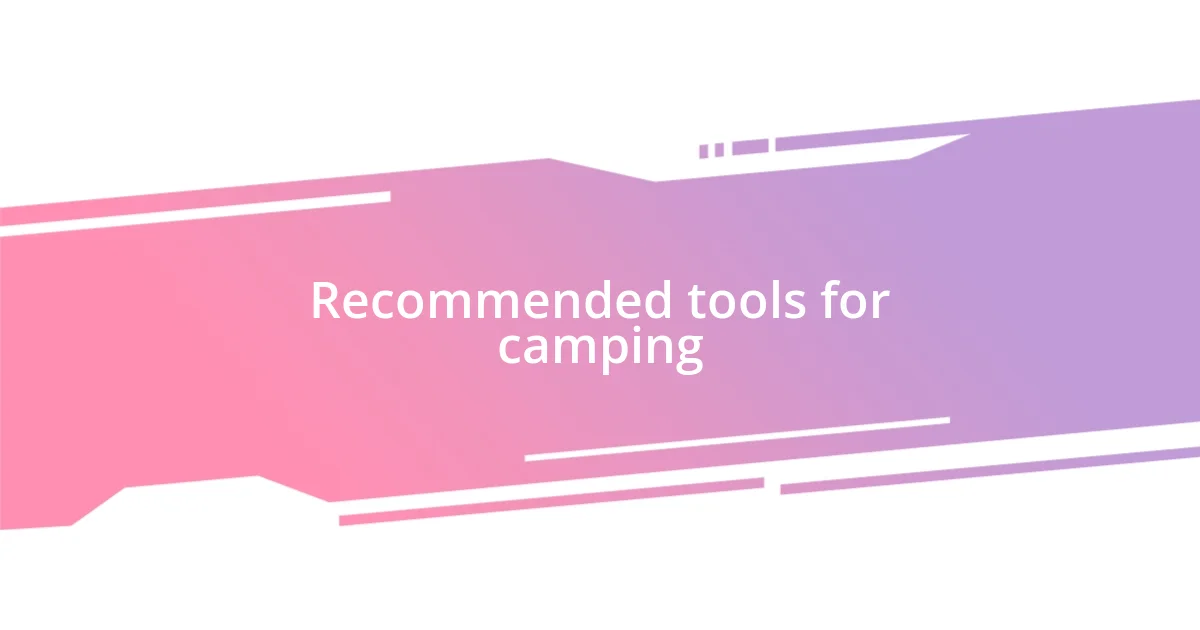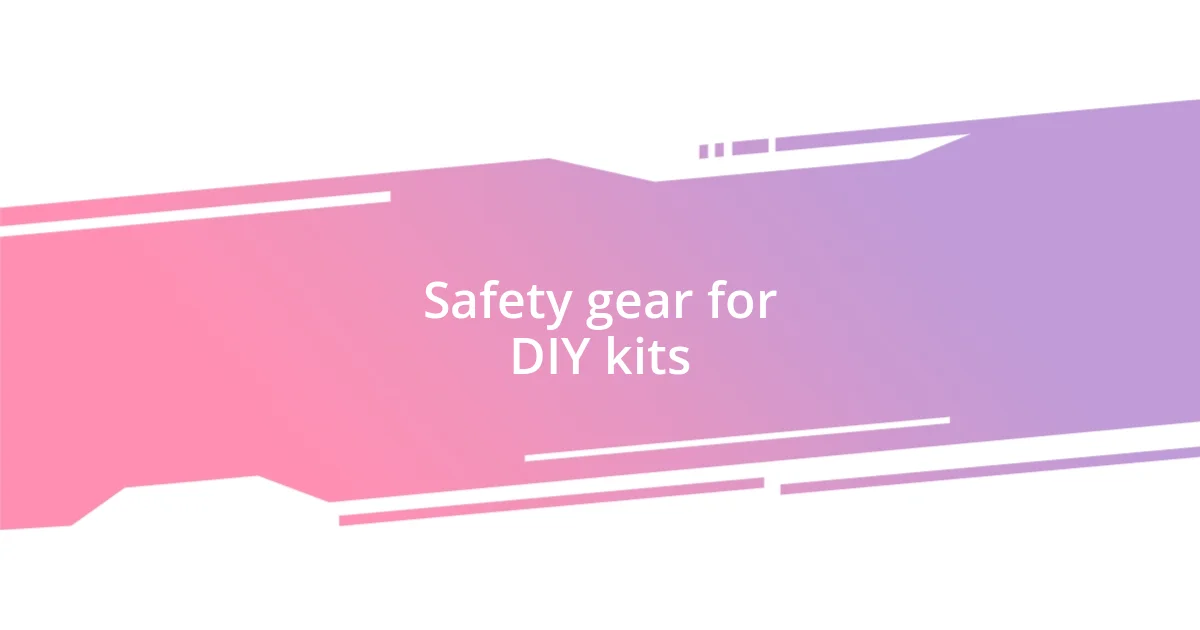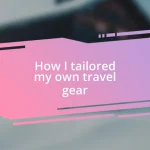Key takeaways:
- Building a DIY camping kit enhances the camping experience through personal customization, adaptability, and the connection it fosters with nature.
- Essential items for a camping kit include a tent, sleeping bag, cooking gear, water filtration system, first aid kit, and navigation tools, all prioritized for comfort and safety.
- Organization and preparation are crucial; using checklists, labeling gear, and practicing setup can prevent forgetfulness and enhance overall outdoor experiences.

Understanding DIY camping kits
A DIY camping kit essentially combines essentials tailored to your specific needs and preferences. When I first ventured out into the wilderness with friends, we discovered the magic of customizing our gear. It made me realize how every part of my kit could enhance my camping experience, whether through comfort, safety, or even just convenience.
Building a DIY camping kit gave me a sense of accomplishment and empowerment. I remember rummaging through my old gear, repurposing a vintage backpack, and finding joy in tweaking my supplies for a better fit. Isn’t it amazing how personalizing these essentials creates a deeper connection to your outdoor adventures?
Understanding a DIY camping kit also means acknowledging its adaptability. As I’ve learned from countless trips, what works for one location might not suit another. Do you remember that time you packed too much gear for a simple overnight stay? I’ve been there too. Crafting your kit allows you to refine it, ensuring you have just the right items to meet the unique challenges of each trip.

Essential items for your kit
When assembling my DIY camping kit, I’ve found that including the right essentials makes all the difference between a memorable adventure and one spent grappling with discomfort or frustration. I vividly recall a trip where my success hinged on having the basics; forgetting a reliable water filter left me parched and on edge. Now, I prioritize items that enhance my comfort and safety, while also being compact and lightweight.
Here are the essential items I recommend for your kit:
- Tent or Tarp: A reliable shelter for protection from the elements.
- Sleeping Bag: Choose one suited for the temperatures you’ll encounter.
- Cooking Gear: A portable stove, fuel, and a durable pot are key.
- Water Filtration System: Ensures access to safe drinking water on the go.
- First Aid Kit: Contains bandages, antiseptics, and any personal medications.
- Flashlight or Headlamp: Essential for navigating after dark, plus extra batteries.
- Multi-tool or Knife: Versatile for various tasks around the campsite.
- Food Supplies: High-energy snacks and meals tailored to your preferences.
- Map and Compass: Always useful, even if you’re relying on your phone’s GPS.

Recommended tools for camping
When it comes to camping tools, my experience has taught me the importance of packing smart. A good multi-tool can be a game-changer. I remember one trip where my multi-tool saved the day—I used it to fix a broken tent pole, allowing us to enjoy our evening without any worries. It’s the little things that can dramatically enhance your experience!
Navigating the wilderness requires more than just basic supplies; quality tools can make all the difference. For instance, a reliable flashlight not only helps you find your way back to camp after a night hike, but it also brings a sense of safety. There was one memorable night when our plans went sideways, and we ended up lost in the dark. With nothing but my trusted headlamp, I felt both vulnerable and empowered as it illuminated our unexpected path.
One crucial tool that I’ve come to appreciate over time is a compact cooking setup. Being able to whip up a warm meal at the campsite can bring an incredible sense of comfort. I still recall a chilly evening where we gathered around our portable stove, sharing laughter and the aroma of hot soup, making the challenges of our hike fade away in warmth and camaraderie.
| Tool | Purpose |
|---|---|
| Multi-tool | Versatile for fixing gear and preparing food |
| Flashlight/Headlamp | Essential for navigation after dark |
| Cooking Setup | Enables warm meals and fosters social gatherings |

Safety gear for DIY kits
When it comes to safety gear, I always make sure to pack a comprehensive first aid kit. In one of my earlier camping trips, I stumbled upon that undeniable truth when a fellow camper cut their hand while attempting to prepare lunch. Fortunately, I had not only bandages but also antiseptic wipes and a few over-the-counter pain relievers. These small items turned what could have been a disastrous day into just a minor hiccup.
I can’t stress enough the importance of having reliable tools that enhance safety, such as a good whistle. While some may overlook it, I remember a time when I became separated from my group during a hike. Calling out loudly was futile, but I still had my whistle, which ultimately guided them back to me. It’s that moment of realization—having something as simple as a whistle can give you peace of mind and potentially save your situation.
In my experience, high-quality safety gear also includes durable gloves. I learned this the hard way when I underestimated the sharp edges of an old campsite grill. After getting a nasty cut, I’ve made it a point to always include gloves in my kit. They may seem like a minor addition, but they can offer an extra layer of protection when handling equipment or setting up camp. Isn’t it reassuring to know that a little preparation can help you avoid unnecessary scrapes and bruises?

Organizing your camping kit
I find that the key to a well-organized camping kit is categorization. When I pack, I create separate bags for cooking, sleeping, and safety gear. This not only helps me locate what I need quickly but also ensures I don’t overlook critical items. I still chuckle at the time I arrived at a campsite and realized I had packed ten pairs of socks but forgot my stove. Lesson learned: it’s not just about packing; it’s about smart packing.
Labeling is something I swear by. Using clear labels for each bag makes it easy to identify contents at a glance, even in fading light. I remember a trip when I fumbled around in the dark, desperately searching for our cooking supplies. If only I had labeled my bags, I wouldn’t have wasted precious time. Wouldn’t it be nice if we could eliminate those little frustrations?
Additionally, I always keep a checklist handy. I’ve crafted a personalized checklist over the years, which I update based on each trip. When I started this habit, it transformed how I prepared for camping. Just last summer, I took it out and realized I’d forgotten my sleeping pad for a weekend trip. While I managed to improvise with extra blankets, having that checklist could have spared me a less-than-comfortable night. I find comfort in knowing I’m covering all my bases with just a quick glance at my list before heading out. What’s in your kit that you can’t afford to forget?

Tips for outdoor preparedness
Being prepared for the outdoors can make all the difference in your experience. I’ve realized that checking the weather forecast before heading out is not just a precaution; it’s essential. I once camped during what was supposed to be a pleasant weekend, only to be caught in an unexpected rainstorm. Let me tell you, facing a downpour without adequate shelter and wet gear turned a fun trip into a wet disaster. Now, I always check the forecast and pack rain gear accordingly—it’s a simple step that can save you a lot of frustration.
Another tip that I swear by is practicing setting up your gear before you hit the trail. I learned this from a rather embarrassing moment on a chilly evening when I struggled with a tent that turned out to have missing parts. It was a race against the encroaching darkness, and I was left fumbling around, hoping I would somehow figure it out. If only I had taken the time to practice beforehand! Knowing how your equipment works can not only save time but also reduce the stress of scrambling to find the right pieces. So, why not spend an afternoon setting up your gear at home?
Lastly, keep in mind the importance of packing extra food and water. I can’t emphasize how pivotal it is if things don’t go as planned. A friend and I once underestimated how far we would hike, and our snacks ran out much sooner than expected. We ended up scavenging for twigs and berries—an experience I wouldn’t wish on anyone! Now, I always pack a few snacks beyond what I think I might need. It’s not about being overly cautious; it’s about having peace of mind and being prepared for the unexpected. What items do you think could save your adventure?

Customizing your kit for adventures
When it comes to customizing your camping kit, think about your specific adventures. For instance, when I plan to hike in a more rugged area, I make sure to include extra safety gear like a compact first-aid kit and a portable phone charger, which I learned to appreciate after my phone died during a remote trek last year. It can be surprising how fast you can feel lost without a reliable connection, especially when navigating unfamiliar terrain—what essentials do you consider for peace of mind?
I also love to incorporate personal elements into my kit that reflect my style. For example, I have a unique cooking pot that I brought back from a local artisan market. Not only does it remind me of that trip, but it also adds a touch of home while cooking in the wilderness. Isn’t it amazing how little things can evoke memories and make our experiences feel richer? Customizing your gear like this can foster a deeper connection to your adventures.
Lastly, don’t shy away from experimenting with multifunctional gear. I recently switched to a sleeping bag that doubles as a blanket, which has proved invaluable on chilly nights around the campfire. I remember snuggling up, feeling cozy and resourceful rather than juggling multiple items. How do you make your gear work harder for you? This kind of thoughtfulness in customizing your kit can enhance both convenience and enjoyment in the great outdoors.














